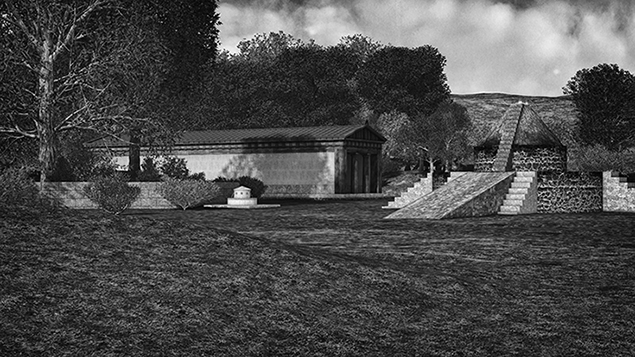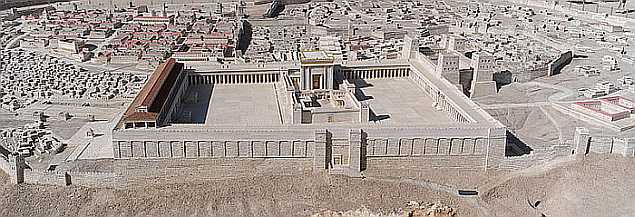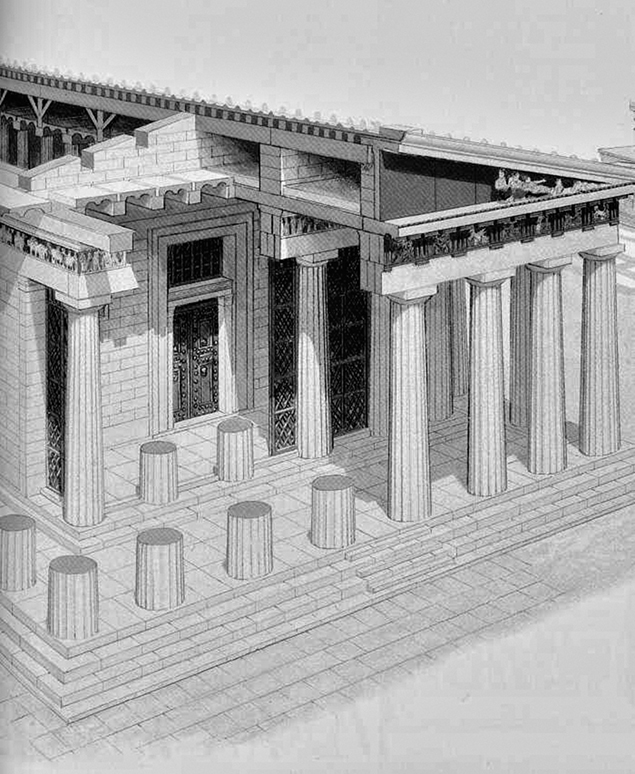|
Griechischer
Tempelbau
- Bearbeiteter Lexikon-Auszug
Der Tempel, Kultbau, in der Regel der Mittelpunkt eines geschlossenen
sakralen Bezirks, eines Heiligen Hains, griechisch Temenos.

Archaischer Temenos in Olympia -
Rekonstruktion Alexander Paffrath - Antikdigital (Copyright)
Alle Hochkulturen brachten charakteristische Tempelanlagen hervor, z.
B. Beispiel der Jahwetempel in Jerusalem.

Das eigentliche Tempelhaus des jüdischen Tempels befand sich
im
innersten Geviert der Vorhöfe. Die ganze Anlage war im
Gegensatz
zu den griechischen Tempeln nach Außen mehrfach verschlossen
und
nur über Tore erreichbar.
Der ursprünglich aus Holz und Lehmziegeln, später aus
Stein
errichtete griechische Tempel bestand in seiner frühesten, dem
mykenischen Megaron entsprechenden Form aus einem rechteckigen, nur vom
Eingang her erhellten Raum (Cella), in dem das Götterbild
stand,
und einer Vorhalle (Pronaos) mit zwei Säulen zwischen den
über die vordere Schmalseite vorgezogenen
Längswänden - Antentempel.
Bei einer anderen frühen Form des Tempels (Prostylos) wurde
die
Vorhalle durch eine vor der Eingangsseite stehende Säulenreihe
gebildet. Wenn die Rückseite des Antentempels oder des
Prostylos
auch eine vorgeblendete Säulenreihe erhielt, entstand der Doppelantentempel oder der
Amphiprostylos.

Die Zeichnung zeigt die östliche Baugliederung Parthenon in
Athen.
Schon im 8. Jahrhundert wurden Tempel mit einer ringsum laufenden
Säulenhalle gebaut - Peripteros,
wie der Zeustempel in Olympia, später auch mit einer doppelten
Säulenreihe (Dipteros). Die Cella wurde durch meist zwei
Säulenreihen in Längsschiffe unterteilt.
Um die Kultsstatuen zu beeindruckender Höhe entwickeln zu
können, wurde die Cella auch mit zweistöckigen
Säulenreihen ausgestattet, so der Zeustempel im Gegensatz zu
dem
mehr archaischen Heraion in Olympia.
Eine Sonderform des Tempelbaus war der von Säulen umgebene
Rundtempel - Tholos z.
B. in Delphi. Tholoi wurden auch als nicht sakrale Bauten
ausgeführt, wie das Philippeion
in Olympia. In Griechenland entwickelte sich der Tempelbau in den drei
Stilrichtungen dorisch (str*e.*),
ionisch (elegant) und korinthisch (feierlich). Am meisten
bekannt sind die dorischen Tempelruinen. Beispiele: Olympia, Athen,
Paestum.
Greek temple construction -
Worked on encyclopaedia extract
of The temples, cult construction, as a rule the centre of a closed
sacred district, a holy grove, in Greek
Temenos .

Archaic Temenos in Olympia - Rreconstruction Alexander Paffrath
(copyright)
All advanced civilisations produced
typical temple arrangements, e.g., example of the Jahwetempel in
Jerusalem.

The real temple house of the Jewish temple was in the most internal
square of the forecourts. The whole arrangement was closed in contrast
to the Greek temples after Outside several times and was accessible
only about gates.
Originally of wood and clay bricks, later of stone established Greek
temples passed in his earliest ones, mykenischen Megaron suitable form
of a rectangular, only from the entrance illuminated space (cella) in
which the image of a god stood, and a vestibule (Pronaos) with two
columns between the Längswänden early about the front
narrow
side - Antentempel .
With another early form of the temple (Prostylos) the vestibule was
formed by a column row standing before the input side. If the back of
the Antentempels or the Prostylos also received a preblinded column
row, originated Doppelantentempel
or the Amphiprostylos.

The drawing shows the eastern construction arrangement Parthenon in
Athens.
Already in the 8th century temples with a portico running all around
were built - Peripteros ,
like the Zeus's temple in Olympia, later also with a double one Column
row (Dipteros). The cella was divided by mostly two column rows in
Längsschiffe.
To be able to develop the cult statues of impressive height, the cella
also became with to 2-storied column rows equipped, according to the
Zeus's temple in contrast to the more archaic Heraion in Olympia.
A special form of the temple construction was the round temple
surrounded by columns - Tholos ,
e.g., in Delphi. Tholoi became also as not sacred constructions
explained, how Philippeion
in Olympia. In Griechenland the temple construction developed in three
style directions Doric
(strictly), Ionically (elegantly) and korinthisch (solemnly) .
The Doric temple ruins are known mostly. Examples: Olympia, Athens,
Paestum.
la
construction de temple grecque - Extrait de
dictionnaire encyclopédique travaille
Des temples, la construction de culte, habituellement, le centre d'un
arrondissement sacré fermé, d'un saint bosquet,
grec
Temenos

Temenos archaïque dans Olympia - la
reconstruction Alexandre Paffrath (le copyright)
Toutes les hautes cultures produisaient les placements de temple
caractéristiques, par exemple, l'exemple de Jahwetempel
à
Jérusalem.

La véritable maison de temple du temple juif se trouvait
dans le
carré le plus intérieur des avant-cours. Toutes
les
installations étaient fermées contrairement aux
temples
grecs après Dehors plusieurs fois et étaient
accessibles
seulement sur des portes.
Initialement du bois et des briques d'argile, plus tard de la pierre
les temples grecs construits il réussissait dans ses
premiers,
mykenischen Megaron la forme correspondante d'un rectangulaire,
seulement de l'entrée l'espace (Cella)
éclairé
dans quoi l'idole se trouvait, et un vestibule (Pronaos) avec deux
colonnes entre Längswänden
préférés sur
le côté étroit avant - Antentempel
A une autre forme tôt du temple (Prostylos), le vestibule
était formé par une rangée de colonnes
se trouvant
devant le côté d'entrée. Bien que le
derrière d'Antentempels ou de Prostylos reçoive
une
rangée de colonnes préaveuglée,
naissait Doppelantentempel
ou Amphiprostylos.

Le dessin montre la division de construction orientale au
Parthénon à Athènes.
Déjà au 8ème siècle, des
temples avec un
hall de colonnes courant tout autour étaient construits - Peripteros ,
comme Zeustempel dans Olympia, plus tard aussi avec une double La
rangée de colonnes (Dipteros). Cella était
divisé
par le plus souvent deux rangées de colonnes dans
Längsschiffe.
Pour pouvoir développer les statues de culte de la hauteur
à impressionner, devenait Cella aussi avec à
rangées de colonnes à 2 étages
équipé, ainsi de Zeustempel contrairement
à
l'Heraion plus archaïque dans Olympia.
Une forme spéciale de la construction de temple
était le
temple rond entouré par des colonnes - Tholos , par exemple,
à Delphi. Tholoi devenaient aussi comme les constructions
non sacrées exporté, comme le Philippeion dans Olympia.
Dans Griechenlad, la construction de temple se développait
dans trois directions de style
dorique (strictement), ionien (élégamment) et
korinthisch (solennellement) . Les ruines de temple
doriques sont connus le plus. Exemples : Olympia, Athènes,
Paestum.
|